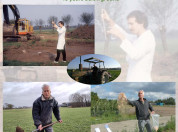Search
Filter by
Type
Tags
Dossiers
Themes
Departments
Active filters
13 search results
Search results
-
From Pioneer to Soil Prophet: 40 years belowground - Farewell symposium Wietse de Boer
On Thursday April 4 we'll have the Farewell Symposium and reception for our long-time colleague Prof. Dr Wietse de Boer (Department of Microbial Ecology at NIOO and Wageningen University).
-
How genetic research contributes to effective lion conservation
Human measures to protect lions have an impact on the genetic health of populations. Dutch and Kenyan scientists discovered this by analysing the DNA of 171 Kenyan lions. "By fencing reserves, for example, the chance of inbreeding increases." With the knowledge and tools from the research, management authorities in Kenya can better protect their valuable wildlife in the future.

-
Biodiversity on the NIOO terrain
At NIOO we strive to stimulate the biodiversity on the green roofs and the terrain. On the occasion of NIOO’s 68th birthday, colleagues launched a BioBlitz: a period of biological surveying to record the living species within a designated area.
-
BiodiversityXL Community Event at NIOO
The next BiodiversityXL Community Event is coming up soon and this time it's going to be at NIOO!
-
Spotlight on living soil at COP15 biodiversity conference
The UN Biodiversity Conference in Montreal (COP15) is discussing global action to reverse biodiversity loss. Healthy, living soil is of key importance.
-
Biodiversity XL Live: The Sound of Biodiversity
Yet another fascinating episode is coming up for the BiodiversityXL Live short livestream series: the Sound of Biodiversity! More and more different approaches and techniques are used, in the hope to gain more knowledge about biodiversity. They help us to look very detailed at individuals, species and ecosystems. But let's not forget about our ears. Sound can tell a lot about the presence of species, but also about their behaviour. Sounds we can hear, like bird songs, but also sounds we can not hear. How do we monitor biodiversity via sound?
-
Multifunctional grounds
Besides the latest ecotechnology, the grounds also feature aviaries, ponds, greenhouses and experimental gardens.
-
Bringing nature into the city
We aim for maximum biodiversity on and around our building. But what can we do to increase it?
-
Awakening sleeping antibiotics with ERC Advanced grant
Facilitating the search for new antibiotics: that's what Gilles van Wezel aims to do by looking at similarities in the DNA of antibiotic-producing bacteria.
-
Farming microbial community for plant probiotic - MicroProFarm
A current challenge for modern agriculture is to meet the food production needs for an increasing global population while improving resource use efficiency and attenuating impacts on human health and environment. In order to maximize reliability and stability in agriculture, optimization of crop management and resource use efficiency have been considered the best approaches for a sustainable increase of crop yields under variable agro-ecological conditions, environments and years. For this purpose, one interesting and sustainable method is the use of natural plant biostimulants, a diverse class of products and microorganisms that enhance plant growth and other plant parameters, such as flowering, fruit set, crop productivity and nutrient use efficiency. In this context, several studies already demonstrated that plant biostimulants can induce morpho-anatomical, biochemical, physiological and molecular plant responses, not only improving crop productivity but also promoting protection against abiotic stresses, such as drought and salinity. Among the different biostimulant classes there are protein hydrolysates (PH), mixtures of polypeptides, oligopeptides and aminoacids originated from partially hydrolyzed animal and vegetal tissues. Even though the effect of PH were already observed in diverse crops, the mechanisms and behind their action are still scarcely studied, and their action can vary depending on their origin, characteristics, crop species, cultivars, growing conditions, time and mode of applications, among other parameters. The objective of this project is to evaluate the effect of protein hydrolysates in the growth, nutrient content and microbial communities of crops, if microbes are responsible for these effects, which are the mechanisms and if such effects are long-lasting.
